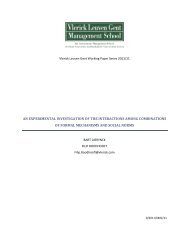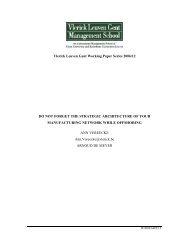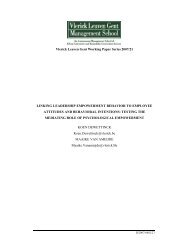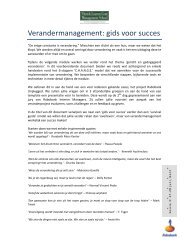Vlerick Leuven Gent Working Paper Series 2007/03 ... - Vlerick Public
Vlerick Leuven Gent Working Paper Series 2007/03 ... - Vlerick Public
Vlerick Leuven Gent Working Paper Series 2007/03 ... - Vlerick Public
You also want an ePaper? Increase the reach of your titles
YUMPU automatically turns print PDFs into web optimized ePapers that Google loves.
It is often because of their outstanding professional achievements that they have been<br />
appointed to the board of directors. At the same time, these individuals are used to sit at the<br />
head of the table and they have their own psychological needs for power, recognition, and<br />
influence. For many of these directors, the setting of a board of directors is (or might be)<br />
sensed as an unusual and uncomfortable situation (Nadler et.al., 2006). Fifth, there exist<br />
complex authority relationships within a board of directors. In contrast to management teams,<br />
the role and position of outside directors do not reflect their status in the company’s hierarchy<br />
(Nadler et.al., 2006). Still, some outside directors may have more authority than others, due<br />
their status in corporate world or the business community at large. Moreover, when the<br />
positions of chairman of the board and CEO are combined, a perplexing power relationship<br />
may exist. A sixth feature relates to the changing expectations of work. Compared to other<br />
teams, the role of the board is often not well-defined and can substantially differ among<br />
companies. In addition, boards of directors are increasingly confronted with unprecedented<br />
scrutiny and (public) pressure (Van den Berghe and Levrau, 2004). As a result, many boards<br />
are struggling to agree on what their tasks are, also vis-à-vis management. Seventh, boards of<br />
directors expose an aura of formality. The format, physical setting, social rituals and conduct<br />
of board meeting create a sense of formality and status which is uncommon among other<br />
teams (Nadler et.al., 2006). Finally, boards of directors encompass a larger number of<br />
members in comparison to the size of other organizational team (Forbes and Milliken, 1999).<br />
Presenting a process-oriented model for board effectiveness<br />
Taking into account these distinctive features, we develop a model of board<br />
effectiveness that bridges some of the gaps in the research on boards of directors (see Figure<br />
1). Drawing on a broad variety of sources (e.g. corporate governance literature, literature on<br />
TMT and group effectiveness, field studies etc.), we distinguish multiple intervening<br />
constructs that we believe mediate the direct impact of board characteristics on firm<br />
performance. The proposed model strongly relies on the input-process-output approach used<br />
in research frameworks for studying organizational teams (e.g. Gladstein, 1984; Cohen and<br />
Baily, 1997). Apart from that, this approach has also inspired other board models (e.g. Forbes<br />
and Milliken, 1999; Huse, 2005).<br />
Insert Figure 1 About Here<br />
9










